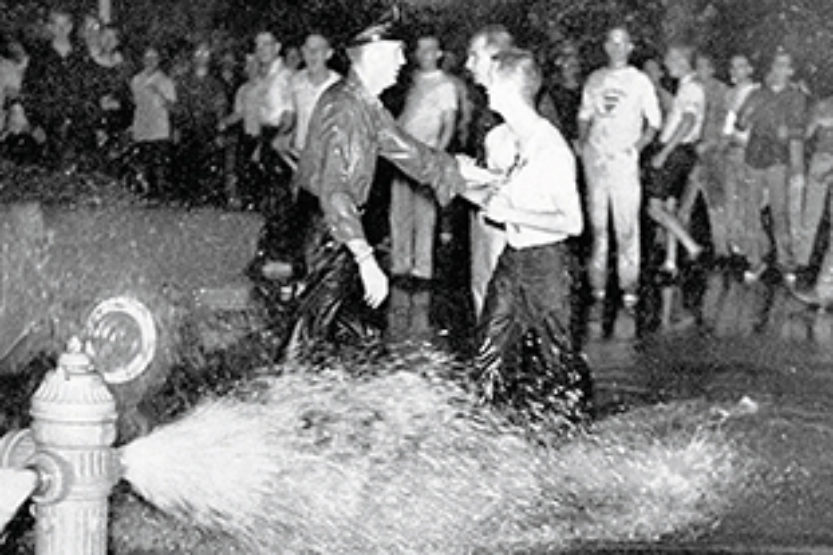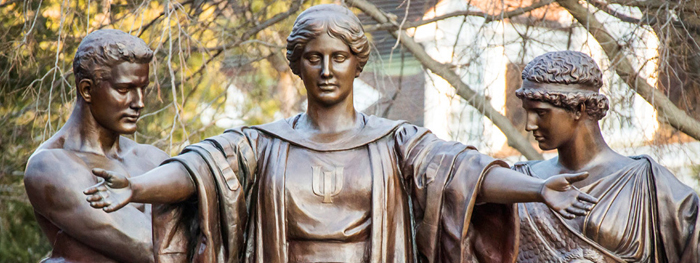The (Water) Fighting Illini
 Water fights at the University of Illinois were not merely wet—they were wicked as well. Members of law enforcement (above) find the streets awash with both water and waywardness. (1961 Illio photo)
Water fights at the University of Illinois were not merely wet—they were wicked as well. Members of law enforcement (above) find the streets awash with both water and waywardness. (1961 Illio photo) It was finals week in 1957 when the inhabitants of three University of Illinois student dwellings decided to cut the tension by dousing each other with water. Before the May 30 evening concluded, anywhere from 3,000 to 5,000 participants—whether driven by stress, boredom, spring weather or simple hijinks—had become immersed in an eight-hour-long “water riot,” and 50 had been arrested.
Beginning with water pistols and ending with tear gas, so began one of the most controversial of UI traditions: water fights.
In the spontaneous ’57 incident, thousands of young men roamed the campus in packs, carrying water in anything that would hold it, from pitchers to water pistols to buckets and wastebaskets. It became a serious mission.
“Passers-by, curious spectators and police were drenched,” reported The (Urbana, Ill.) Courier the next day. People in cars and buses were “baptized,” fire hydrants opened to collect ammunition, and some student houses took in a foot of water.
When rocks began to fly and a police car was hammered with iron bars, law enforcement from five neighboring counties converged on campus, and “every officer got doused with water,” Champaign County Sheriff Everett Hedrick told The Courier. The paper reported that police resorted to firing more than 100 rounds of tear gas when a mob of roughly 300 headed for the downtown lockup, yelling, “Let’s spring the guys they got in jail!” The water riot drew headlines as far away as New York City.
One year later, it became obvious that the melee wasn’t a one-time uproar. “Here We Go Again!” shouted The Daily Illini headline on April 18, 1958, when an estimated 6,000 students reprised the water fight, some of them taunting, “We want tear gas!”
Lou Liay, EDM ’62, served as manager of the Fourth Street Residence Halls from 1958 to 1962. He is amazed he didn’t get hurt—or wet.
“There were hundreds of guys around the fire hydrant at the Armory, and they were going to open it, so I went in and took the wrench out of their hands,” recalls Liay, a former president of the University of Illinois Alumni Association. “I tell you, I was crazy. My legs were shaking, and I was a nervous wreck. But they all dispersed.”
By 1959, the administration was prepared, with beefy Illinois lettermen guarding the fire hydrants and, in some cases, stomping on buckets. Consequently, that year’s water fight didn’t make much of a splash, despite a student’s attempt to rouse the crowd by dressing as Cuban revolutionary Fidel Castro and waving a toy machine gun.
After its serendipitous beginning, ensuing water fights became skillfully planned—and covert—according to Champaign attorney Bob Auler ’62 LAS, JD ’65 LAW. Announcements for the impending onslaught would appear the week before, stenciled onto sidewalks, but, “like [operatives in] a Cold War cell,” he says the identity of the coordinators remained hidden.
“You got your stencil materials left in a secret drop location, like behind the second toilet in the second-floor men’s room in Gregory Hall,” he recalls. “It was so well-organized that you couldn’t rat anybody out even if you wanted to.”
Nonetheless, traitors existed. According to Auler, who stayed out of the fray, a University security assistant with “an eyeball the shape of a keyhole” used an undercover student who flushed out violators engaged in a range of possible misdeeds.
In 1960, the wetworks returned with a vengeance. When Marilyn Michal ’63 BUS, EDM ’70, and some of her friends ventured out (even though their residence hall, Busey-Evans, had been locked down, as had all UI women’s housing), they beat a quick retreat upon observing coeds being dunked at an open fire hydrant.
The tradition hit its watershed moments in 1961 when a newsman had an eye put out. Despite occasional attempts to revive it throughout the ’60s, the annual event dribbled to a close.
Auler, however, thinks that a rumor—allegedly spread by UI administration—drained the event of its last bit of enthusiasm. Word was that dye would be dropped onto the crowd from helicopters, and, by using a black light to identify those who got stained, administrators would prevent the students from taking finals. As numerous students had been expelled and disciplined for water fighting in previous years, the rumor was taken seriously.
Auler sees the 20-year trend—from water fights in the ’50s to Vietnam War protests in the ’60s to streaking in the ’70s—as all rising from the same motivation: students pushing back at authority.
Pushback or not, for an administrator like Liay, “It was a heck of a time.
“You always kind of prayed for rain.”

